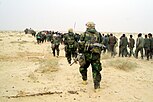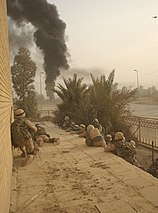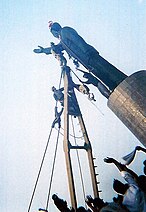
Back غزو العراق Arabic غزو العراق (2003) ARZ ABŞ və müttəfiqlərinin İraqa müdaxiləsi (2003) Azerbaijani Уварванне ў Ірак (2003) Byelorussian ২০০৩-এর ইরাক আক্রমণ Bengali/Bangla Rat u Iraku 2003. BS Invasió de l'Iraq de 2003 Catalan داگیرکردنی عێراق لە ساڵی ٢٠٠٣ CKB Invasionen af Irak 2003 Danish Herbê Iraqi DIQ
| 2003 invasion of Iraq غزو العراق (Arabic) داگیرکردنی عێراق (Kurdish) | |||||||
|---|---|---|---|---|---|---|---|
| Part of the War on terror and the Iraq War | |||||||
Clockwise from top-left: American troops from the 2nd Battalion, 1st Marine Regiment, escort Iraqi prisoners of war to a holding area in the desert; American convoy of Humvees in northern Iraq during a sandstorm; Iraqi civilians cheer as American soldiers topple Saddam Hussein's statue in Baghdad's Firdos Square; American troops from the 2nd Battalion, 325th Airborne Infantry Regiment, watch an Iraqi paramilitary's headquarters burn in Samawah | |||||||
| |||||||
| Belligerents | |||||||
|
Coalition of the willing
|
| ||||||
| Commanders and leaders | |||||||
|
|
| ||||||
| Strength | |||||||
|
Total: 589,799 |
Total: 1,311,000 650,000 reserves[13][14] 4,000 tanks[15] 3,700 APCs and IFVs 2,300 artillery pieces 300 combat aircraft[16] SRG: 12,000 RG: 75,000 Fedayeen Saddam: 30,000 Arab volunteers: 6,000[17] | ||||||
| Casualties and losses | |||||||
Total: 747+
|
Total: 30,000+
| ||||||
| Estimated Iraqi civilian fatalities: | |||||||
The United States-led invasion[b] of the Republic of Iraq was the first stage of the Iraq War. The invasion began on 19 March 2003 and lasted just over one month,[26] including 26 days of major combat operations, in which a combined force of troops from the United States, the United Kingdom, Australia and Poland invaded Iraq. Twenty-two days after the first day of the invasion, the capital city of Baghdad was captured by coalition forces on 9 April after the six-day-long Battle of Baghdad. This early stage of the war formally ended on 1 May when U.S. President George W. Bush declared the "end of major combat operations" in his Mission Accomplished speech,[27] after which the Coalition Provisional Authority (CPA) was established as the first of several successive transitional governments leading up to the first Iraqi parliamentary election in January 2005. U.S. military forces later remained in Iraq until the withdrawal in 2011.[28]
The coalition sent 160,000 troops into Iraq during the initial invasion phase, which lasted from 19 March to 1 May.[29] About 73% or 130,000 soldiers were American, with about 45,000 British soldiers (25%), 2,000 Australian soldiers (1%), and ~200 Polish JW GROM commandos (0.1%). Thirty-six other countries were involved in its aftermath. In preparation for the invasion, 100,000 U.S. troops assembled in Kuwait by 18 February.[29] The coalition forces also received support from the Peshmerga in Iraqi Kurdistan.
According to U.S. President George W. Bush and UK Prime Minister Tony Blair, the coalition aimed "to disarm Iraq of weapons of mass destruction [WMD], to end Saddam Hussein's support for terrorism, and to free the Iraqi people", even though the UN inspection team led by Hans Blix had declared it had found no evidence of the existence of WMDs just before the start of the invasion.[30][31] Others place a much greater emphasis on the impact of the September 11 attacks, on the role this played in changing U.S. strategic calculations, and the rise of the freedom agenda.[32][33] According to Blair, the trigger was Iraq's failure to take a "final opportunity" to disarm itself of alleged nuclear, chemical, and biological weapons that U.S. and British officials called an immediate and intolerable threat to world peace.[34]
In a January 2003 CBS poll, 64% of Americans had approved of military action against Iraq; however, 63% wanted Bush to find a diplomatic solution rather than go to war, and 62% believed the threat of terrorism directed against the U.S. would increase due to war.[35] The invasion was strongly opposed by some long-standing U.S. allies, including the governments of France, Germany, and New Zealand.[36][37][38] Their leaders argued that there was no evidence of weapons of mass destruction in Iraq and that invading that country was not justified in the context of UNMOVIC's 12 February 2003 report. About 5,000 chemical warheads, shells or aviation bombs were discovered during the Iraq War, but these had been built and abandoned earlier in Saddam Hussein's rule before the 1991 Gulf War. The discoveries of these chemical weapons did not support the government's invasion rationale.[39][40] In September 2004, Kofi Annan, United Nations Secretary-General at the time, called the invasion illegal under international law and said it was a breach of the UN Charter.[41]
On 15 February 2003, a month before the invasion, there were worldwide protests against the Iraq War, including a rally of three million people in Rome, which the Guinness World Records listed as the largest-ever anti-war rally.[42] According to the French academic Dominique Reynié, between 3 January and 12 April 2003, 36 million people across the globe took part in almost 3,000 protests against the Iraq war.[43]
The invasion was preceded by an airstrike on the Presidential Palace in Baghdad on 20 March 2003. The following day, coalition forces launched an incursion into Basra Governorate from their massing point close to the Iraqi-Kuwaiti border. While special forces launched an amphibious assault from the Persian Gulf to secure Basra and the surrounding petroleum fields, the main invasion army moved into southern Iraq, occupying the region and engaging in the Battle of Nasiriyah on 23 March. Massive air strikes across the country and against Iraqi command and control threw the defending army into chaos and prevented an effective resistance. On 26 March, the 173rd Airborne Brigade was airdropped near the northern city of Kirkuk, where they joined forces with Kurdish rebels and fought several actions against the Iraqi Army, to secure the northern part of the country.
The main body of coalition forces continued their drive into the heart of Iraq and were met with little resistance. Most of the Iraqi military was quickly defeated and the coalition occupied Baghdad on 9 April. Other operations occurred against pockets of the Iraqi Army, including the capture and occupation of Kirkuk on 10 April, and the attack on and capture of Tikrit on 15 April. Iraqi president Saddam Hussein and the central leadership went into hiding as the coalition forces completed the occupation of the country. On 1 May, President George W. Bush declared an end to major combat operations: this ended the invasion period and began the period of military occupation.
- ^ Graham, Bradley (7 April 2003). "U.S. Airlifts Iraqi Exile Force For Duties Near Nasiriyah". The Washington Post. Archived from the original on 8 August 2007. Retrieved 13 September 2009.
- ^ Cite error: The named reference
USNewsandworldreportwas invoked but never defined (see the help page). - ^ [1][2]
- ^ Ephraim Kahana; Muhammad Suwaed (2009). The A to Z of Middle Eastern Intelligence. Scarecrow Press. p. 208. ISBN 978-0-8108-7070-3.
- ^ "Iraqi political groupings and individuals". middleeastreference.org.uk. Archived from the original on 5 March 2007.
- ^ Masters of Chaos, Chapter 13 p. 7 Archived 2012-02-14 at the Wayback Machine
- ^ "CNN.com - U.S.: Patriots down Iraqi missiles - Mar. 20, 2003". edition.cnn.com. Retrieved 5 September 2023.
- ^ "CNN.com - Missile hits Kuwait City mall - Mar. 28, 2003". edition.cnn.com. Retrieved 5 September 2023.
- ^ "Iraq launches Scud missiles | World news | The Guardian". amp.theguardian.com. Retrieved 5 September 2023.
- ^ Carter, Linwood B. (28 November 2005). "Iraq: Summary of U.S. Forces" (PDF). Archived (PDF) from the original on 11 May 2009. Retrieved 19 July 2009.
- ^ Cite error: The named reference
PolishSpecialForceswas invoked but never defined (see the help page). - ^ Cite error: The named reference
MajPeltierwas invoked but never defined (see the help page). - ^ Anthony H. Cordesman (28 June 2002). "If We Fight Iraq: Iraq and The Conventional Military Balance" (PDF). Center for Strategic and International Studies. Archived from the original (PDF) on 7 August 2011. Retrieved 18 July 2011.
- ^ Toby Dodge (16 November 2002). "Iraqi army is tougher than US believes". The Guardian. Archived from the original on 5 March 2017. Retrieved 10 November 2012.
- ^ Ricks, Thomas E. (2006). Fiasco: The American Military Adventure in Iraq. Penguin. p. 117. ISBN 978-1-59420-103-5.
- ^ "IRAQ: Iraq's Prewar Military Capabilities". Council on Foreign Relations. Archived from the original on 14 December 2018. Retrieved 14 December 2018.
- ^ "Foreign Irregulars in Iraq". washingtoninstitute.org. 10 April 2003. Archived from the original on 3 April 2019. Retrieved 3 April 2019.
- ^ "Iraq Coalition Casualties: Fatalities by Year and Month" Archived 6 February 2016 at the Wayback Machine iCasualties.org. Retrieved 1 November 2009.
- ^ icasualties Iraq Coalition Casualties: U.S. Wounded Totals Archived 24 December 2011 at the Wayback Machine
- ^ Willing to face Death: A History of Kurdish Military Forces – the Peshmerga – from the Ottoman Empire to Present-Day Iraq (page 67) Archived 29 October 2013 at the Wayback Machine, Michael G. Lortz
- ^ a b "The Wages of War: Iraqi Combatant and Noncombatant Fatalities in the 2003 Conflict". Commonwealth Institute of Cambridge. Archived from the original on 2 September 2009. Retrieved 13 September 2009.
- ^ "Wages of War – Appendix 1. Survey of reported Iraqi combatant fatalities in the 2003 war". Commonwealth Institute of Cambridge. Archived from the original on 2 September 2009. Retrieved 13 September 2009.
- ^ "Body counts". By Jonathan Steele. The Guardian. 28 May 2003.
- ^ Iraq Body Count project Archived 9 November 2009 at the Wayback Machine. Source of IBC quote on undercounting by media is Press Release 15 :: Iraq Body Count.
- ^ Malovany, Pesach (21 July 2017). Wars of Modern Babylon: A History of the Iraqi Army from 1921 to 2003. University Press of Kentucky. ISBN 9780813169453 – via Google Books.
- ^ "U.S. Periods of War and Dates of Recent Conflicts" (PDF). Congressional Research Service. 29 November 2022. Archived (PDF) from the original on 28 March 2015. Retrieved 4 April 2015.
- ^ "Political Circus: 'Mission Accomplished' finds a home". www.cnn.com. Retrieved 24 February 2022.
- ^ Gordon, Michael; Trainor, Bernard (1 March 1995). The Generals' War: The Inside Story of the Conflict in the Gulf. New York: Little Brown & Co.
- ^ a b "U.S. has 100,000 troops in Kuwait". CNN. 18 February 2003. Archived from the original on 8 November 2012. Retrieved 29 October 2011.
- ^ Cite error: The named reference
beginning1was invoked but never defined (see the help page). - ^ "UN INSPECTORS FOUND NO EVIDENCE OF PROHIBITED WEAPONS PROGRAMMES AS OF 18 MARCH WITHDRAWAL, HANS BLIX TELLS SECURITY COUNCIL | Meetings Coverage and Press Releases". www.un.org. Retrieved 15 February 2022.
- ^ "US Hardliners search for a Saddam connection". Gulf States Newsletter's Middle East Insider (9). September 2001. Archived from the original on 16 May 2013. Retrieved 7 March 2013.
- ^ Oz Hassan (2012) Constructing America's Freedom Agenda for the Middle East
- ^ "President Bush Meets with Prime Minister Blair". Georgewbush-whitehouse.archives.gov. 31 January 2003. Archived from the original on 12 March 2011. Retrieved 13 September 2009.
- ^ "Poll: Talk First, Fight Later" Archived 30 March 2007 at the Wayback Machine. CBS, 24 January 2003. Retrieved 23 April 2007.
- ^ An exception was Denmark, where even the popular opinion supported the invasion and Denmark as a member of the coalition. Joint Declaration by Russia, Germany and France on Iraq France Diplomatie 10 February 2003
- ^ NZ praised for 'steering clear of Iraq war' Archived 15 May 2011 at the Wayback Machine The Dominion Post, 7 December 2008.
- ^ Beltrame, Julian (31 March 2003). "Canada to Stay out of Iraq War". Maclean's. Archived from the original on 18 May 2008. Retrieved 19 January 2009.
- ^ Hoar, Jennifer (23 June 2006). "Weapons Found In Iraq Old, Unusable". CBS News. Archived from the original on 1 April 2019. Retrieved 14 March 2019.
- ^ Chivers, C.J. (14 October 2014). "The Secret Casualties of Iraq's Abandoned Chemical Weapons". The New York Times. Archived from the original on 7 January 2015.
- ^ MacAskill, Ewen; Borger, Julian (15 September 2004). "Iraq war was illegal and breached UN charter, says Annan". The Guardian. Retrieved 3 November 2022.
- ^ "Guinness World Records, Largest Anti-War Rally". Guinness World Records. Archived from the original on 4 September 2004. Retrieved 11 January 2007.
- ^ Callinicos, Alex (19 March 2005). "Anti-war protests do make a difference". Socialist Worker. Archived from the original on 21 March 2006. Retrieved 9 December 2015.
Cite error: There are <ref group=lower-alpha> tags or {{efn}} templates on this page, but the references will not show without a {{reflist|group=lower-alpha}} template or {{notelist}} template (see the help page).
© MMXXIII Rich X Search. We shall prevail. All rights reserved. Rich X Search



